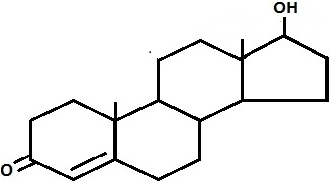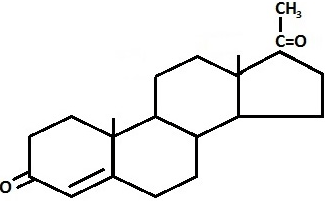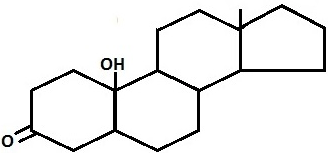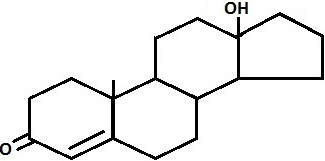This set of Molecular Endocrinology Multiple Choice Questions & Answers (MCQs) focuses on “Gonadal Hormones-Androgens”.
1. What are the three types of gonadal hormones?
a) Androgens, Oestrogens and Gestogens
b) Androgens, Oestrogens and progesterone
c) FSH, LH and Androgens
d) Androgens, Gestogens and FSH
View Answer
Explanation: Sex hormones or gonadal hormones are formed mainly by the testes, ovary and corpus luteum, and also by the placenta and adrenal cortex in limited amounts. They are of three types namely, androgens, Oestrogens and Gestogens.
2. Which among the following is the correct structure of testosterone?
a)

b)

c)

d)

View Answer
Explanation: Testosterone is one of the naturally occurring androgens. At C10 and C13, it has a CH3 group and contains 19 C atoms. Phentolamine is a synthetic imidazoline with the activity of an alpha-adrenergic antagonist.
3. Where are androgens synthesized and released in males?
a) Sertoli cells
b) Liver
c) Testes
d) Urethra
View Answer
Explanation: Androgens are synthesized in testes (Leydig cells) in males. It is also produced from the adrenal cortex in certain amounts. The other androgens that serve testosterone functions are released primarily by the adrenal cortex.
4. Androgens are hormones that are capable of generating some characteristic effects that are masculine.
a) True
b) False
View Answer
Explanation: Androgens are hormones that are capable of generating some characteristic masculinizing effects. That is, they conserve the natural structure and function of the prostate and seminal vesicles and affects the production of secondary characteristics of the sex of males, such as hair distribution and expression.
5. Androstenedione is the immediate precursor of testosterone in the delta4 pathway.
a) True
b) False
View Answer
Explanation: Androstenedione is formed from progesterone. It is converted to testosterone by the enzyme 17-βOH steroid dehydrogenase. Androstenedione is testosterone’s immediate precursor in the delta4 pathway of androgen synthesis which is the major pathway in humans.
6. Which among the following are the precursor for the synthesis of androgens?
a) Citrate and Cholesterol
b) Acetate and Cholesterol
c) Acetate and citrate
d) Cholesterol and Lipids
View Answer
Explanation: From either (1) acetate (‘active’ acetate) or (2) cholesterol, androgens may be produced. In this reaction, Pregnenolone is a major intermediate. The precursor of the five main steroid hormone groups is cholesterol. These hormones include progestagens, glucocorticoids, mineralocorticoids, androgens, and estrogens.
7. In which cell organelle does the pregnenolone gets converted into testosterone?
a) Smooth Endoplasmic Reticulum
b) Mitochondria
c) Cytoplasm
d) Golgi bodies
View Answer
Explanation: In the Leydig cell mitochondria (adrenal cortex-like pathway), cholesterol is transferred to pregnenolone. Pregnenolone is then moved to the smooth endoplasmic reticulum to synthesise testosterone.
8. Which are the two pathways for the synthesis of androgens?
a) Delta1 pathway and Delta5 pathway
b) Delta4 pathway and Delta3 pathway
c) Delta2 pathway and Delta5 pathway
d) Delta4 pathway and Delta5 pathway
View Answer
Explanation: There are mainly two pathways for the synthesis of androgens. They are the delta4 and delta5 pathways. In humans mainly the delta4 pathways is predominating. Androgens are generated predominantly in the gonads (testicles and ovaries) and also in the adrenal glands and are synthesized from cholesterol.
9. Which are the two enzymes that convert pregnenolone to progesterone in the delta4 pathway of androgen synthesis?
a) 3-β-OH steroid dehydrogenase and an isomerase
b) 5-β-OH steroid dehydrogenase and an isomerase
c) 17-β-OH steroid dehydrogenase and an isomerase
d) 213-β-OH steroid dehydrogenase and an isomerase
View Answer
Explanation: Pregnenolone, catalyzed by the enzymes, 3-β-OH steroid dehydrogenase, and isomerase, is converted to ‘Progesterone’ in the delta4 pathway of androgen synthesis. This is a major initial step in the delta4 pathway of androgen synthesis.
10. Which enzyme converts Androstenedione to testosterone in the delta4 pathway of androgen synthesis?
a) 17-α-hydroxylase
b) 17-β-OH steroid dehydrogenase
c) 17-α-OH-progesterone
d) 3-β-OH steroid dehydrogenase
View Answer
Explanation: Progesterone is hydroxylated by 17-alpha-hydroxylase to form 17-alpha-OH-progesterone, which, by the enzyme lyase, loses its side chain to form ‘androstenedione.’ Androstenedione is reduced by 17-βOH steroid dehydrogenase at the C17 position to form “testosterone.”
11. In the delta5 pathway of androgen synthesis, pregnenolone is converted to which molecule?
a) Progesterone
b) Cholesterol
c) 17-α-OH-pregnenolone
d) 18-α-OH-pregnenolone
View Answer
Explanation: Pregnenolone is converted to 17-alpha-OH-pregnenolone in the delta5 pathway by the 17-a-hydroxylase enzyme. This pathway is not so common in human beings. A much greater amount is provided by the testicles than by the ovaries.
12. Which is the intermediate product in the delta5 pathway of androgen synthesis?
a) Androstenedione
b) Cholesterol
c) Dehydroepiandrosterone (DHEA)
d) Pregnenolone
View Answer
Explanation: Dehydroepiandrosterone (DHEA) is the intermediate product in the delta5 pathway of androgen synthesis. This is formed from 17-α-OH pregnenolone by the lyase enzyme. Dehydroepiandrosterone, also referred to as androstenolone, is an endogenous precursor to steroid hormones.
13. Which enzyme leads to the formation of testosterone from DHEA in the delta5 pathway of androgen synthesis?
a) 18-β-OH steroid dehydrogenase
b) 17-α-hydroxylase
c) 3-β-OH steroid dehydrogenase
d) 17-β-OH steroid dehydrogenase
View Answer
Explanation: DHEA is first reduced to form delta5 androstenediol by 17-β-OH steroid dehydrogenase. This then undergoes reduction and isomerization in order to form testosterone. 17β-Hydroxysteroid dehydrogenases and 17-ketosteroid reductases (17-KSR) are a group of alcohol oxidoreductases that in steroidogenesis and steroid metabolism catalyze the reduction of 17-ketosteroids and the dehydrogenation of 17β-hydroxysteroids.
14. Which enzyme converts circulating DHEA-SO4 into free DHEA?
a) Sulfatase
b) Lyase
c) Acetylase
d) Dehydrogenase
View Answer
Explanation: Circulating DHEA-SO4 from the adrenal cortex can be converted by a sulfatase enzyme to form ‘free DHEA’ in the testes. This gives the testosterone precursor an additional source. Sulfatases are esterase-class enzymes that catalyze sulphate ester hydrolysis.
15. What is the active form of testosterone called?
a) Pregnenolone
b) Dihydrotestosterone (DHT)
c) Tetrahydrotestosterone
d) Cholesterol
View Answer
Explanation: In the testes and extra testicular tissues such as the prostate, seminal vesicles and target tissues, testosterone is transformed into a more “active” and potent form, called “Dihydrotestosterone” (DHT). This is done by reducing the delta5-double bond via a reductase and NADPH.
Sanfoundry Global Education & Learning Series – Molecular Endocrinology.
To practice all areas of Molecular Endocrinology, here is complete set of 1000+ Multiple Choice Questions and Answers.
If you find a mistake in question / option / answer, kindly take a screenshot and email to [email protected]
